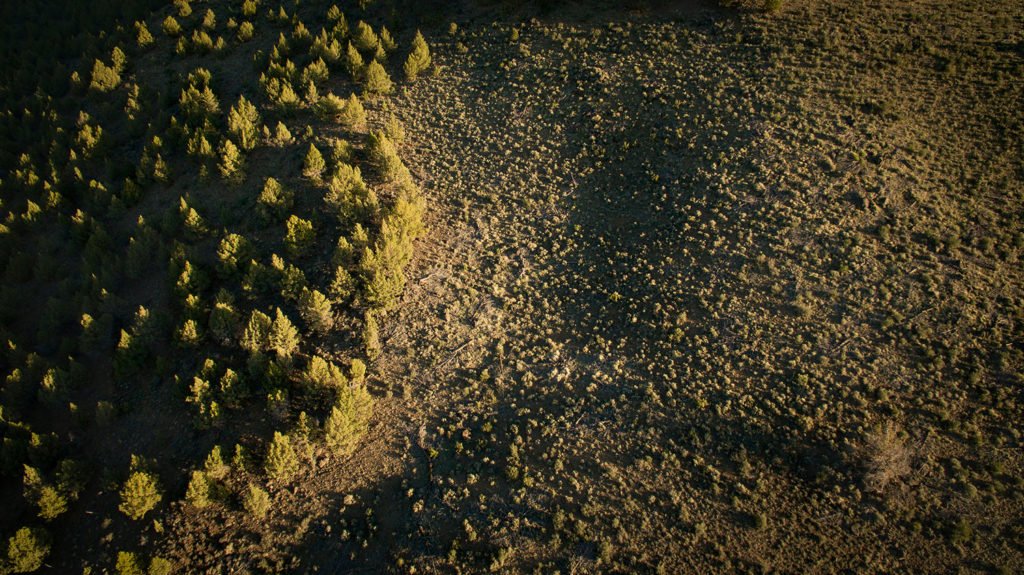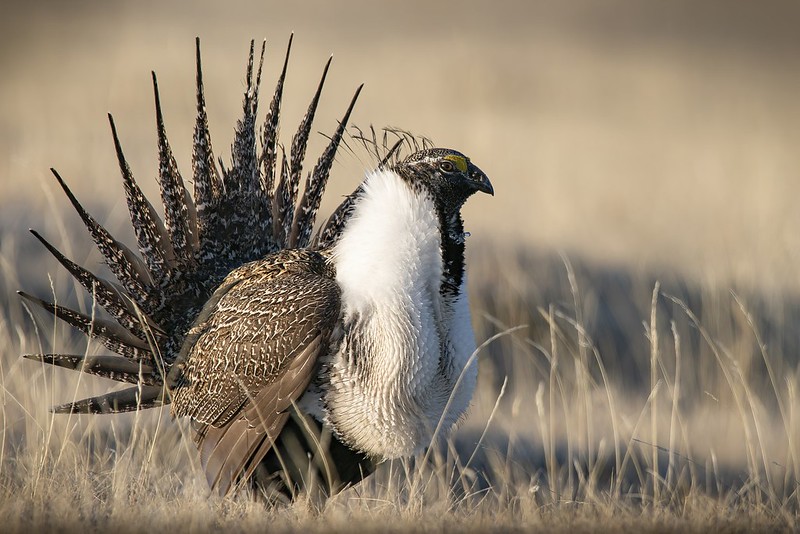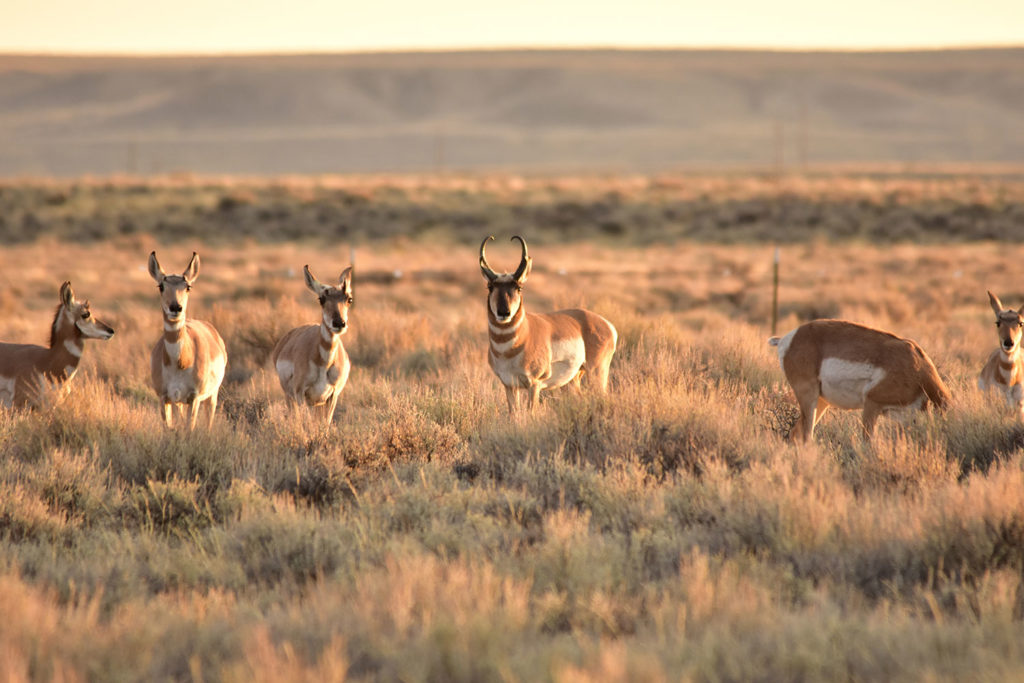Pinyon-Juniper Encroachment: Effects on Sagebrush-Dependent Wildlife

Key Points
- Pinyon-juniper encroachment alters wildlife habitat through conversion from an open shrubland with a diversity of plant species to a dense woodland.
- Healthy sagebrush habitat hosts a diverse component of plant and animal species including some of the most iconic Western species, such as sage-grouse, pronghorn, elk and mule deer.
- Tree removal that helps return sagebrush and herbaceous plant cover is beneficial to numerous species of wildlife.
What is pinyon-juniper encroachment?
Pinyon-juniper encroachment is the expansion of pinyon-juniper woodlands into ecosystems that historically were shrublands or grasslands. These tree species have increased in abundance due to fire suppression, land use and favorable climate. A significant portion of this encroachment occurs in sagebrush rangelands and affects many processes within these ecosystems.

Altered habitat
The encroachment of pinyon-juniper into rangelands affects wildlife abundance and diversity by altering and fragmenting habitat. Sagebrush ecosystems can have a diversity of herbaceous plants that provide food and cover for numerous species of wildlife. As tree cover increases, however, these shrubs, grasses and forbs compete with trees for resources. Trees decrease soil water availability on the landscape and impact the diversity and quantity of herbaceous plants. Encroachment can also influence streamflow, which affects surface water available for wildlife. Additionally, pinyon-juniper encroachment increases the risk of larger, high severity fires due to increased amounts of fuel, leading to further loss of habitat and greater potential for non-native species invasion. This loss and alteration of both habitat and resources affects many wildlife species.
Sagebrush ecosystems provide habitat for over 350 species of plants and animals, with several animal species entirely dependent upon sagebrush for habitat, many of which are now under conservation concern. These sagebrushobligate species include the greater sage-grouse, pygmy rabbit, sagebrush vole, Brewer’s sparrow, sage thrasher, sage sparrow and sagebrush lizard. Loss of sagebrush habitat not only affects obligate species, but also harms the many other species associated with sagebrush ecosystems including reptiles, small mammals and birds, and also ungulates such as pronghorn, mule deer and other big game. For example, small mammal diversity decreases with pinyon-juniper encroachment, while mule deer avoid areas of high tree cover due to changes in habitat and forage availability.

A bellwether of change
As a species of significant conservation concern, the greater sage-grouse has become well-known as an indicator of sagebrush ecosystem health. Due to sage-grouse dependence on healthy sagebrush communities for every phase of its life cycle, the decreasing health of sage-grouse populations is linked to declining sagebrush habitat. Over 90% of the pinyonjuniper encroachment has occurred in sagebrush ecosystems, contributing to significant habitat loss for sage-grouse. This species is an early bellwether of ecosystem degradation, as they begin avoiding areas with only one to two trees per acre. Not only does nesting and rearing habitat degrade with encroachment, but trees also become perches for avian predators such as raptors and ravens.

Pinyon-juniper management for wildlife
Management that increases or maintains sagebrush and herbaceous cover is beneficial for many wildlife populations, and treatment of pinyon-juniper encroachment can lead to a fast recovery of understory plant cover and diversity. Studies have shown that populations of sagebrush-associated bird species considered at high conservation concern, such as the Brewer’s sparrow and the green-tailed towhee, more than doubled after tree removal, while densities of small mammals also improved with conifer treatment. Additionally, overwinter survival of mule deer has been shown to increase as a result of greater abundance of browse species after management. Tree removal not only reduces trees for sage-grouse predators and restores sagebrush habitat, but it also reduces the risk of severe wildfire and associated loss of habitat.
Restoration of sagebrush ecosystems has been proven to benefit populations of sage-grouse. Within three years after treatment, survival of both individuals and nests can improve, while population growth rates increased 12 % in areas of restored habitat five to six years after conifer removal. Due to the sage grouse’s sensitivity to the quality and quantity of sagebrush habitat, it is considered an umbrella species, where management to improve habitat for this animal is also likely to benefit other sagebrush associated species. Research investigating the overlap of species’ distributions have found that many animals, such as the pygmy rabbit, several reptile species and other bird species, may also benefit from sage-grouse management. Restoring large, intact and resilient sagebrush habitat will benefit numerous wildlife species.
References
» Bates, J., Davies, K., & Svejcar, T. (2016). Juniper treatments and herbaceous production. In: Ochoa, C., and DeBoodt, T. [compilers]. Range field day, June 2016, Ecology and hydrology of western juniper, special report. Corvallis, OR, USA: Oregon State University, Agricultural Experiment Station. p. 46−53.
» Bates, J. D., Davies, K. W., Bournoville, J., Boyd, C., O’Connor, R., & Svejcar, T. J. (2019). Herbaceous biomass response to prescribed fire in juniper encroached sagebrush steppe. Rangeland Ecology and Management, 72(1), 28–35.
» Bergman, E. J., Bishop, C. J., Freddy, D. J., White, G. C., & Doherty, P. F. (2014). Habitat management influences overwinter survival of mule deer fawns in Colorado. The Journal of Wildlife Management, 78(3), 448–455.
» Casazza, M. L., Coates, P. S., & Overton, C. T. (2011). Linking habitat selection and brood success in greater sage-grouse. In: B. K. Sandercock, K. Martin, and G. Segelbacher (editors). Ecology, conservation, and management of grouse. Studies in Avian Biology (no. 39), University of California Press, Berkeley, CA. p. 151-167. » Donnelly, J. P., Tack, J. D., Doherty, K. E., Naugle, D. E., Allred, B. W., & Dreitz, V. J. (2017). Extending conifer removal and landscape protection strategies from sage-grouse to songbirds, a range-wide assessment. Rangeland Ecology & Management, 70(1), 95–105.
» Hamilton, B.T., Roeder, B.L., & Horner, M.A., (2019). Effects of sagebrush restoration and conifer encroachment on small mammal diversity in sagebrush ecosystem, Rangeland Ecology & Management, 72(1), 13–22. » Holmes, A. L., Maestas, J. D., & Naugle, D. E. (2017). Bird responses to removal of western juniper in sagebrush-steppe. Rangeland Ecology & Management, 70(1), 87–94.
» Kormos, P. R., Marks, D., Pierson, F. B., Williams, C. J., Hardegree, S. P., Havens, S., Hedrick, A., Bates, J. D., & Svejcar, T. J. (2017). Ecosystem water availability in juniper versus sagebrush snow-dominated rangelands. Rangeland Ecology & Management, 70(1), 116–128.
» Miller, R. F., Chambers, J. C., Evers, L., Williams, C. J., Snyder, K. A., Roundy, B.A., & Pierson, F. B. (2019). The ecology, history, ecohydrology, and management of pinyon and juniper woodlands in the Great Basin and Northern Colorado Plateau of the western United States. Gen. Tech. Rep. RMRS-GTR-403. Fort Collins, CO: U.S. Department of Agriculture, Forest Service, Rocky Mountain Research Station. 284 p.
» Maestas, J.D., Naugle, D.E., Chambers, J.C., Tack, J.D., Boyd, C.S., & Tague, J.M. (2021). Conifer Expansion [Chapter M.]. In: Remington, Thomas E.; Deibert, Patricia A.; Hanser, Steven E.; Davis, Dawn M.; Robb, Leslie A.; Welty, Justin L. Sagebrush conservation strategy-Challenges to sagebrush conservation. Open-File Report 2020-1125. Reston, VA: US Geological Survey. p. 139-152.
» Morano, S., Stewart, K. M., Dilts, T., Ellsworth, A., & Bleich, V. C. (2019). Resource selection of mule deer in a shrub-steppe ecosystem: influence of woodland distribution and animal behavior. Ecosphere, 10(11), e02811.
» Olsen, A. C., Severson, J. P., Maestas, J. D., Naugle, D. E., Smith, J. T., Tack, J. D., Yates, K. H., & Hagen, C. A. (2021). Reversing tree expansion in sagebrush steppe yields population-level benefit for imperiled grouse. Ecosphere, 12(6), e03551.
» Pilliod, D. S., Jeffries, M. I., Arkle, R. S., & Olson, D. H. (2020). Reptiles under the conservation umbrella of the greater sage-grouse. The Journal of Wildlife Management, 84(3), 478–491.
» Roundy, B.A., Miller, R.F., Tausch, R.J., Young, K., Hulet, A., Rau, B., Jessop, B., Chambers, J. C., & Eggett. D. (2014). Understory cover responses to piñon–juniper treatments across tree dominance gradients in the Great Basin. Rangeland Ecology and Management, 67(5), 482-494.
» Rowland, M. M., Suring, L. H., Leu, M., Knick, S.T., & Wisdom, M.J. (2011). Sagebrush-associated species of conservation concern. In: S. E. Hanser, M. Leu, S. T. Knick and C. L. Aldridge, editors. Sagebrush ecosystem conservation and management: ecoregional assessment tools and models for the Wyoming Basins. Allen Press, Lawrence, Kansas, USA. p. 46-68.
» Schroeder, M. A., Aldridge, C. L., Apa, A. D., Bohne, J. R., Braun, C. E., Bunnell, S. D., Connelly, J. W., Deibert, P. A., Gardner, S. C., Hilliard, M. A., Kobriger, G. D., McAdam, S. M., McCarthy, C. W., McCarthy, J. J., Mitchell, D. L., Rickerson, E. V., & Stiver, S. J. (2004). Distribution of sage-grouse in North America. The Condor, 106(2), 363–376.
» Severson, J.P., Hagen, C.A., Tack, J.D., Maestas, J.D., Naugle, D.E., & Forbes, J.T. (2017). Better living through conifer removal: A demographic analysis of sage-grouse vital rates. PLoS ONE 12(3), e0174347.
» Smith, I. T., Rachlow, J. L., Svancara, L. K., McMahon, L. A., & Knetter, S. J. (2019). Habitat specialists as conservation umbrellas: Do areas managed for greater sage-grouse also protect pygmy rabbits? Ecosphere, 10(8), e02827.
» Wisdom, M. J., Rowland, M. M., & Suring, L. H. (2005). Habitat threats in the sagebrush ecosystem: methods of regional assessment and applications in the Great Basin. Lawrence, Kansas: Alliance Communications Group. 301 p